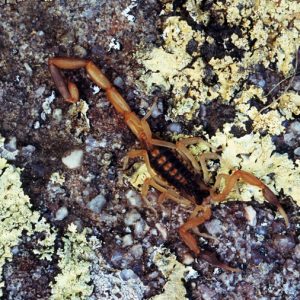calsfoundation@cals.org
Striped Bark Scorpions
aka: Centruroides vittatus
The striped bark scorpion, Centruroides vittatus, is the only scorpion species recorded from Arkansas, where it is most abundant in the western part of the state. It is the most widely distributed scorpion species in the United States, having been recorded from Missouri, Arkansas, and Louisiana west to eastern Colorado and New Mexico and south to northeastern Mexico.
The front body region, which bears the yellowish-brown pedipalps (pincers) and legs below, has a somewhat triangular median dark spot on top pointing backward and extending beyond the eyes. The wide body region that follows has a distinctive pair of broad, dark, longitudinal bands on top. The slender tail-like postabdomen is uniformly yellowish brown, except for the tip of the stinger, which is dark brown or black. A distinctive small tooth is present at the base of the slender, curved stinger. Adults grow to about 2½” long.
Striped bark scorpions live in a wide variety of microhabitats in deciduous and pine forests, grasslands, and deserts. They rest under loose bark, rocks, or logs, as well as in wood piles, crumbling foundations, and similar sheltered places during the day. Because they do not burrow, they are exposed to freezing temperatures during winter, but many, if not most, recover after having been frozen. Scorpions emerge from their shelters after sunset, frequently climbing trees, shrubs, and even walls of houses at night. Arkansas scorpions tend to roam considerably during April, May, and early June, and they commonly enter houses, where they are often found in attics.
Striped bark scorpions prey primarily on spiders and insects. They capture prey with their pedipalps and subdue it with venom from their stingers. Cannibalism is common, at least in food-stressed populations. An elaborate mating ritual occurs in fall, spring, and early summer. A litter of some thirty live young appears in about eight months, clinging to their mother’s back until they molt for the first time, in about five to fifteen days. They mature in three to four years.
Scorpion stings often occur when people turn over wood or rocks with bare hands. The venom of the striped bark scorpion is of low toxicity to humans, and most stings are of minor medical importance, although reactions vary with the sensitivity of the person stung. The usual symptoms are immediate sharp pain and local swelling. The pain soon subsides, but it may be followed by numbness or tingling caused by nerve irritation. Nausea, dizziness, vomiting, and tightness of the chest may occur. Severe allergic reactions and death are not likely outcomes of striped bark scorpion stings.
For additional information:
Baerg, William J. Scorpions: Biology and Effect of their Venom. University of Arkansas Agricultural Experiment Station Bulletin 649. Fayetteville: University of Arkansas, 1961.
Dorris, Peggy Rae. “Phosphorescent Animal Forms of Arkansas.” Proceedings of the Arkansas Academy of Science 25 (1971): 69.
Polis, Gary A., ed. The Biology of Scorpions. Stanford, CA: Stanford University of Press, 1990.
Shelly, Rowland M., and W. David Sissom. “Distributions of the Scorpions Centruroides vittatus (Say) and Centruroides hentzi (Banks) in the United States and Mexico (Scorpiones, Buthidae).” Journal of Arachnology 23 (1995): 100–110.
Yamashita, Tsunemi. “Surface Activity, Biomass, and Phenology of the Striped Scorpion, Centruroides vittatus (Buthidae) in Arkansas, USA.” Euscorpius 17 (2004): 25–33.
Jeffrey K. Barnes
University of Arkansas Arthropod Museum
 Science and Technology
Science and Technology Striped Bark Scorpion
Striped Bark Scorpion 



My nephew found an adult scorpion in his backpack this morning.
While I was building beehive equipment, a one-inch brown scorpion, fast, stung me. Bite was stinging, with numbness, swelling. I bled the finger within minutes.
I found one in my mailbox on May 23, 2016, so look before you reach!